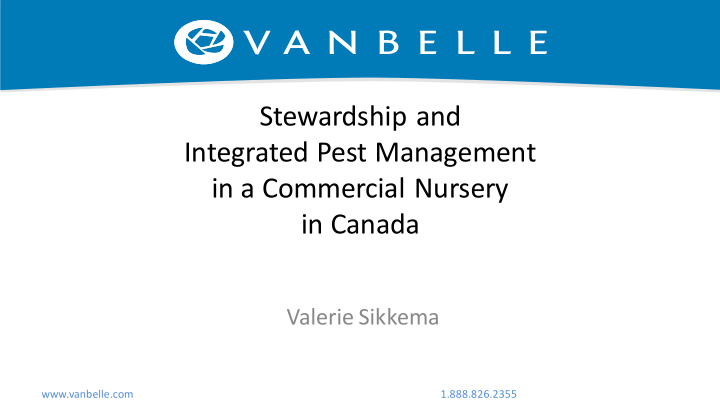



Stewardship and Integrated Pest Management in a Commercial Nursery in Canada Valerie Sikkema www.vanbelle.com 1.888.826.2355
www.vanbelle.com 1.888.826.2355
Our fearless leaders www.vanbelle.com 1.888.826.2355
Field of Deciduous Shrubs for Retail Ready www.vanbelle.com 1.888.826.2355
www.vanbelle.com 1.888.826.2355
Field of evergreens for Retail Ready www.vanbelle.com 1.888.826.2355
www.vanbelle.com 1.888.826.2355
What is Integrated Pest Management (IPM) • An ecosystem based strategy for pest control that focuses on long-term prevention of pests. • IPM uses a combination of techniques such as: biological control, habitat manipulation, modification of cultural practices and use of resistant varieties to keep pest levels under threshold and avoid overuse of chemicals. • Rather than correcting a problem once it arises, we simply use all the tools in our toolbox to prevent that a problem from occurring – prevention versus correction. www.vanbelle.com 1.888.826.2355
Biocontrol at VBN • We have used beneficial nematodes to control weevil larvae since early 2000’s. • In 2007 I attended some biocontrol seminars at Kwantlen University in Langley and learned a lot about what was available to the nursery industry. • In 2008 we began experimenting with more biocontrols, first to control aphids and mites. www.vanbelle.com 1.888.826.2355
Aphids : Aphidius colemani and ervi www.vanbelle.com 1.888.826.2355
Aphid Mummies Picture from University of Maryland extension www.vanbelle.com 1.888.826.2355
Aphids on Hibiscus • Hibiscus covered with black aphids every year, resulting in poor quality crop, slow growth and rooting. • Aphidius colemani released using a small container with holes. • Timing is critical – just as the leaf buds open • No more aphids on our Hibiscus crop, and the health and rooting has greatly improved. www.vanbelle.com 1.888.826.2355
Mites: Phytoseiulus persimilis and Neoseiulus californicus. Picture supplied by Koppert www.vanbelle.com 1.888.826.2355
Troubles with mite control • P. persimilis favour high humidity, and the 2 spotted spider mites preferred the low humidity environment that we were using to prevent DM. • Failure to control mites meant spraying miticides which also ended up killing the beneficials. www.vanbelle.com 1.888.826.2355
Success story with mites • Summer 2013 – a huge outbreak of mites on roses • We sprayed 6 different chemicals in 6 weeks – worse than ever! • I suggested that we STOP all sprays and use bios in one house first (and we had success so used them in all houses). • We used Amblyseius cucumeris, Stethorus punctillum , and P. persimilis (later in the fall) • It took 5 weeks to achieve good control. • Since then we use Very little chemical control except as a clean up before shipping. www.vanbelle.com 1.888.826.2355
Stethorus punctillum www.vanbelle.com 1.888.826.2355
Stethorus success story • One year we bought 100 Stethorus to be released in a rose house to control mites and then we forgot about them. • The following year they were found controlling mites in Salvia nearby. • We collected Salvia leaves and moved the Stethorus back to the roses. www.vanbelle.com 1.888.826.2355
• Complete mite control was achieved that same year • Expensive to start, but excellent control - now we use in other high value crops and get the benefit all over the nursery. • Bonus: They don’t eat P. persimilis eggs. www.vanbelle.com 1.888.826.2355
Thrips: Orius laevigatus Picture supplied by Koppert www.vanbelle.com 1.888.826.2355
Things we have learned: • Trial and error, you need to see what works for each crop, each pest, in each growing environment. • Be persistent, use them every year & don’t give up. • Keep your eyes open to find beneficials in the environment. www.vanbelle.com 1.888.826.2355
• Scouting is vital – look for beneficials when you are looking for pests. You might not need to release beneficials if they are already on the crop (save $) • All chemical controls need to be used carefully, because they can kill beneficials (usually often before the pests) and lead to new outbreaks. www.vanbelle.com 1.888.826.2355
Communicate! • Communication with growers is important – so they don’t kill the beneficials unknowingly by spraying or even pruning them off! • Communication with sales team – they need to know what the beneficials look like so they can tell customers that call about “bugs” on their plants. www.vanbelle.com 1.888.826.2355
More words of wisdom • Using fewer chemical sprays means more native beneficials will naturally populate crops. • Growers need to adjust their tolerance to pests – the threshold to spray needs to be higher when using biocontrols. • Limit sprays to “clean up” before shipping . • Patience needed, beneficials take TIME. www.vanbelle.com 1.888.826.2355
Sharing Stewardship with the public The Ornamental Horticulture industry needs to spend more time educating the public about the benefits of gardening: • Reduce lawn area (carbon footprint) • Produce their own food (health) • General health benefits to being outside and around plants • Healthy gardens are a major contributor to healthy ecosystems Bugs are not all bad! www.vanbelle.com 1.888.826.2355
Recommend
More recommend